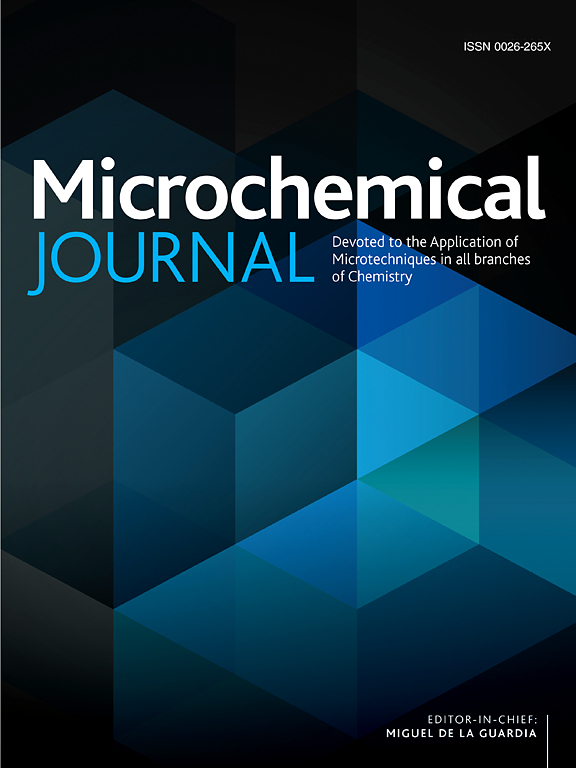A novel sensitive scandium-plumbagin complex: Characterization and fluorescence spectrophotometric application for scandium determination in ceramic samples
IF 4.9
2区 化学
Q1 CHEMISTRY, ANALYTICAL
引用次数: 0
Abstract
Scandium (Sc), a rare earth element, has increasingly been used in various fields such as aerospace, electronics and advanced materials. Accurate and highly sensitive Sc analysis is very important in practice. However, existing analytical methods are often limited in sensitivity, selectivity or require complex equipment. In this paper, a new complex of Sc(III) and plumbagin was studied. The optimal conditions were established: λex = 500 nm and λem = 600 nm, optimal pH from 5.5 to 6.5, acetonitrile:water ratio of 1:3 (V/V), and most of the metal ions were unaffected and stable at room temperature. Based on UV–Vis, fluorescence, FT-IR, 1H NMR, 13C NMR, ESI-MS, XPS, and quantum calculations, it was confirmed that the complex had a ratio of 1:2 (Sc:PLB) with a stability constant of 5.06 × 106 M−2; on that basis, the complex structure was proposed. For development and validation, the values of method detection limit (MDL), limit of quantification (LOQ), relative standard deviation (RSD), recovery, and repeatability (RSDR) were determined as 0.06 ppm, 0.18 ppm, 0.34 %, 99.4 % − 100.5 %, and 0.52–1.11 %, respectively. Those values confirmed that it can be applied for analytical purposes. The proposed method has high selectivity and sensitivity, requires simple equipment, and simplicity, was successfully applied to analyze Sc in ancient glacial ceramics, providing valuable insights into their provenance and manufacturing techniques. The analytical results were consistent when compared with those obtained by neutron activation analysis (NAA), affirming the accuracy and reliability of the proposed method. This research provides a promising and practical method for Sc analysis, contributing to advances in analytical chemistry and related fields.
一种新型灵敏的钪-铅金配合物:表征及荧光分光光度法测定陶瓷样品中钪的应用
钪(Sc)是一种稀土元素,在航空航天、电子和先进材料等各个领域的应用越来越广泛。准确、灵敏的Sc分析在实际应用中具有重要意义。然而,现有的分析方法往往在灵敏度、选择性或需要复杂的设备方面受到限制。本文研究了一种新的Sc(III)与白蜡甙配合物。确定了最佳条件:λex = 500 nm, λem = 600 nm,最佳pH为5.5 ~ 6.5,乙腈:水比为1:3 (V/V),大多数金属离子在室温下不受影响且稳定。通过UV-Vis、荧光、FT-IR、1H NMR、13C NMR、ESI-MS、XPS和量子计算,证实配合物的Sc:PLB比为1:2,稳定常数为5.06 × 106 M−2;在此基础上,提出了复合结构。为建立和验证方法,测定方法的检出限(MDL)、定量限(LOQ)、相对标准偏差(RSD)、回收率和重复性(RSDR)分别为0.06 ppm、0.18 ppm、0.34%、99.4% ~ 100.5%和0.52 ~ 1.11%。这些值证实了它可以用于分析目的。该方法选择性高,灵敏度高,设备简单,操作简单,已成功应用于古冰川陶瓷中的Sc分析,为其来源和制造技术提供了有价值的见解。分析结果与中子活化分析(NAA)结果一致,证实了该方法的准确性和可靠性。本研究为分析化学及相关领域的发展提供了一种有前途的实用方法。
本文章由计算机程序翻译,如有差异,请以英文原文为准。
求助全文
约1分钟内获得全文
求助全文
来源期刊

Microchemical Journal
化学-分析化学
CiteScore
8.70
自引率
8.30%
发文量
1131
审稿时长
1.9 months
期刊介绍:
The Microchemical Journal is a peer reviewed journal devoted to all aspects and phases of analytical chemistry and chemical analysis. The Microchemical Journal publishes articles which are at the forefront of modern analytical chemistry and cover innovations in the techniques to the finest possible limits. This includes fundamental aspects, instrumentation, new developments, innovative and novel methods and applications including environmental and clinical field.
Traditional classical analytical methods such as spectrophotometry and titrimetry as well as established instrumentation methods such as flame and graphite furnace atomic absorption spectrometry, gas chromatography, and modified glassy or carbon electrode electrochemical methods will be considered, provided they show significant improvements and novelty compared to the established methods.
 求助内容:
求助内容: 应助结果提醒方式:
应助结果提醒方式:


